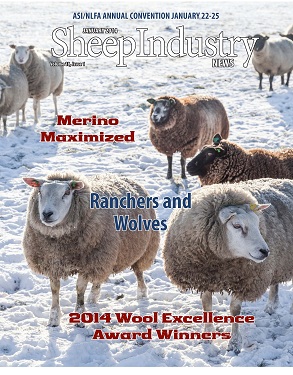
- January 2014
- President’s Notes
- Market Report
- Mackenzie, Lunsford Earn Wool Excellence Awards
- Lamb Nutrition, Industry Research Helps Creamery Grow
- NDSU Hosts Shearing, Classing Schools
- Can Southwest Ranchers Find Peace With Wolves in Their Midst?
- Merino Maximized
- Snapshot 2014: Cornerstone Updates its Efforts on Behalf of ASI, Sheep Producers
- Idaho Ranchers Chip in for Wolf Control
- USDA Releases Report on Sheep Health
- Sheep Trailing Tradition Failing
- Site’s Goal is to Link Growers to Landowners
- Obituaries
To View the January 2014 Digital Issue – Click Here
President’s Notes
Convention a good place to see all pieces of our industry
Clint Krebs
ASI President
The New Year is here and, on our operation, January is when the work starts. The shearers will be here in a couple of weeks and lambing will begin around the 20th of the month. The first lambs to hit the ground are always exciting, but somehow by the end of April, when the last of the ewe lambs finish lambing, the excitement level just isn’t the same.
I guess this is why it is called work.
One of the most interesting bits of information I have picked up is the fact that for every 1,000 ewes in the sheep industry, 18 jobs are created. I know we all seem to concentrate on the extra help we need at lambing or shearing, but the next time you pick up a wool bag, think about the people who made it, or the truck drivers who hauled the wool to wool processors. We can visualize the meat cutters who harvest our lambs, but what about the people who make the trays the cuts are placed on, or the people who work in the retail counters putting them on the shelves? I do not know what the “job created numbers” are for other agriculture industries, but it sure makes getting through lambing easier knowing we are providing jobs for others.
Thinking about everyone involved in the sheep industry is probably why ASI has been so successful. When the association was formed via the 1989 merger of the National Wool Growers Association and the American Sheep Producers Council, the goal was efficiency to handle both lobbying and product promotion with one board instead of two. In fact the bylaws then described the purpose to promote the entire sheep industry.
Obviously, with the expiration of the National Wool Act promotion funds, ASI didn’t have funding for most industry- wide promotions any longer, yet the organization still sought to benefit everyone in the sheep business. ASI created the National Sheep Industry Improvement Center to benefit all sectors, from producers to companies, and ASI did likewise with the petition to form the industry-wide lamb checkoff that we know today.
It is clear to me ASI programs like the “Let’s Grow” campaign involve all segments of our business and ultimately strengthen all segments.
Along those lines, the annual convention is upon us and this is a great opportunity to see some of the other “18 jobs” we help create. The convention tours will take you through wool processing facilities, where our raw wool is turned into beautiful apparel. This processing has always fascinated me. It is similar to watching an artist paint a picture by putting some paint on a canvas and then adding more paint, and pretty soon the canvas becomes a snow covered mountain with a blue lake in the foreground.
We also have great speakers lined up, and just listening to David Kohl will make it worth attending the convention. As a bonus, even if the weather is bad in South Carolina in January, it will be 10 times better than the weather in Billings, Montana.
Speaking of travel, on a flight into Denver last month, my seat mate asked what I did for a living. I could tell she was a little apprehensive about flying, so I thought a conversation might help calm her. I explained that I ran a ranch and raised sheep and cattle, and also grew crops. I realized almost immediately she had no concept where her food came from, other than the grocery store, but she kept chattering. She soon asked where I was from, and I answered “Ione, Oregon.” Her next comment was where I stopped the conversation, because I realized there was no way I was going to educate someone who said “Well, if you own Oregon that must be a pretty big ranch”.

